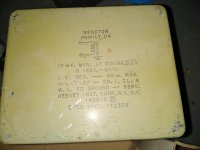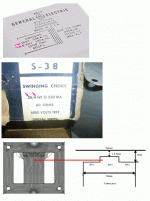Probably not. A swinger would likely specify a range of current and a corresponding range of inductance. It's a serious choke, however.
Was hoping to use it in a choke input power supply @200ma. I guess I could rig up the power supply with a dummy load and see if it rattles and buzzes.
Last edited:
Probably not. A swinger would likely specify a range of current and a corresponding range of inductance. It's a serious choke, however.
It's does say 10H MIN, which got me wondering if it was a swinging choke. If there is a MIN inductance, there should be a MAX?
You do not really have to use a swinging choke in a choke input filter. It just saves some cost and weight to have a swinging choke.
If the choke is potted and rated for 400ma, you are probably fine.
If the choke is potted and rated for 400ma, you are probably fine.
You do not really have to use a swinging choke in a choke input filter. It just saves some cost and weight to have a swinging choke.
If the choke is potted and rated for 400ma, you are probably fine.
That's what I was thinking too, I have a pair of these chokes and I really want to use them (they take up a lot of storage space), they are impressive @ over 20lbs a piece!
You do not need a swinging choke for a constant load.
The reason for a swinging choke is to meet the low current requirement which requires a high critical inductance.
For example an amplifier with 400volts plate 50ma idle and 200ma peak.
400 volts/50ma gives you 8H required for critical inductance.
You only need 2H with the 200ma load. So you can allow the inductance to drop when the current is over 50ma and save a bit of weight. They just put a very small gap in the choke so it has high inductance at low current but that will drop inductance with current.
The reason for a swinging choke is to meet the low current requirement which requires a high critical inductance.
For example an amplifier with 400volts plate 50ma idle and 200ma peak.
400 volts/50ma gives you 8H required for critical inductance.
You only need 2H with the 200ma load. So you can allow the inductance to drop when the current is over 50ma and save a bit of weight. They just put a very small gap in the choke so it has high inductance at low current but that will drop inductance with current.
The key rating for a choke input application is the 125Vac rating, even though that is at 60Hz and not 120Hz. Not many chokes specify that type of level.
You would also only likely get 7-9H if using in a CLC filter application.
You would also only likely get 7-9H if using in a CLC filter application.
The key rating for a choke input application is the 125Vac rating, even though that is at 60Hz and not 120Hz. Not many chokes specify that type of level.
You would also only likely get 7-9H if using in a CLC filter application.
So, 125vac is good for choke input?
A choke input filter applies a much higher AC voltage across the choke itself, as compared to a choke in a more typically seen (nowadays) CLC configured filter where the choke may only have 5-10Vrms across it.
Not only does a choke for a choke input filter have a higher Vac across it, it experiences a higher peak working voltage (B+ level plus a contribution from the AC peak) for the same B+ output level benchmark.
Not only does a choke for a choke input filter have a higher Vac across it, it experiences a higher peak working voltage (B+ level plus a contribution from the AC peak) for the same B+ output level benchmark.
It's does say 10H MIN, which got me wondering if it was a swinging choke. If there is a MIN inductance, there should be a MAX?
10H 400ma !!!!! Must be a big mama of a choke ya.
10H 400ma !!!!! Must be a big mama of a choke ya.
Yes, they are over 20lbs each 😀
- Home
- Design & Build
- Parts
- Swinging Choke?

